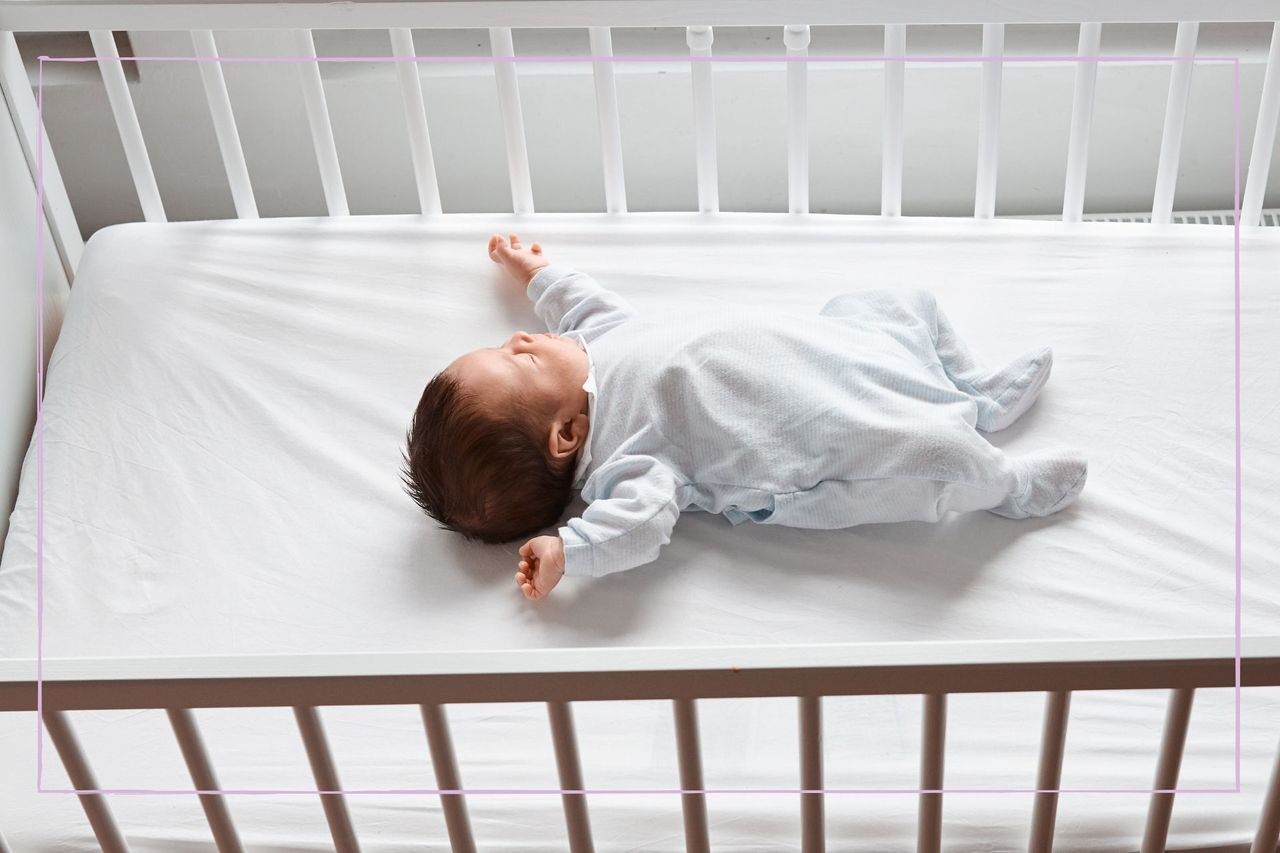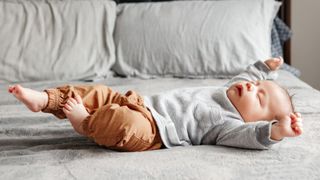Active sleep in newborns - what it looks like, why it happens, and how long it lasts
Active sleep in newborns is a stage of sleep that might not be what you expect... read on to find out more

Hannah Bott
'Active sleep in newborns' is a popular Google search made by parents all over the world. This is great, as it's an important part of your new baby's sleep pattern and one that ideally shouldn't be interrupted.
As a parent, it's natural to have questions and concerns about your newborn's sleep patterns, from how to keep them consistent to the best cot mattress and even which sleep aides to use. One particular phase you may encounter is active sleep, which plays a crucial role in your baby's growth and development.
Mum-of-one, Jess tells us; "There are a lot of things people never tell you about having a baby, one you may notice from the beginning is just how noisy newborns are. They snuffle, snore, wriggle, stretch. All Hollywood has ever shown us is perfectly still-sleeping newborns. All of this activity was unexpected for me, well that and the sleep regressions."
What Jess is describing is 'active sleep', we might also know it as REM (Rapid Eye Movement) sleep. In this article, we explore further what active sleep is, what it looks and sounds like, and why it's important not to disturb your wriggling newborn during this vital sleep stage.
Active sleep in newborns
During active sleep, your newborn's brain activity is remarkably similar to that of an awake state, according to a study from the Journal of Pediatric Psychology . This phase is characterized by rapid eye movements, irregular breathing, twitching or jerking of limbs, and facial expressions. These movements might resemble gentle twitches, sucking motions, or even smiles.
What does active sleep in newborns sound like?
While it's essential to note that every baby is unique, the sounds accompanying active sleep may include soft cooing, murmuring, sighing, or occasional cries. These sounds are a normal part of the sleep cycle and are usually indicative of your baby's brain activity during REM sleep.
Mum-of-one Steph tells us; "My mum knew this but didn't know that there was science to back it up. I remember when my son was a newborn she would say 'leave him be unless he cries for you, that wriggling is him getting comfortable or he might have just had a wee', and she was right. My instinct was a reactive rush and pick him up but it wasn't needed."
GoodtoKnow Newsletter
Parenting advice, hot topics, best buys and family finance tips delivered straight to your inbox.
Baby sleep expert, Hannah Bott shared this on her Instagram page, confessing that not recognising active sleep in newborns was one of her 'biggest mistakes' as a new mum.
A post shared by Hannah • Private & NHS Sleep specialist (@throughthenight.sleep)
A photo posted by on
How long does active sleep last in newborns?
Active sleep duration in newborns can vary, but on average, it accounts for approximately 50% of their total sleep time. While the specific length of active sleep episodes can fluctuate, studies from the Oxford Academic Sleep journal have provided insights into the typical duration. And, our baby sleep expert Hannah Bott agrees, she tells us; "Active Sleep is one of two stages of sleep that happens for Newborns. Active sleep and deep sleep are the two stages of sleep and they look very different. When your newborn is in deep sleep, they will look as you would expect them to - still and quiet. In active sleep, they can move around, open their eyes, flutter their eyes, cry out, grunt, and moan. They will appear like they are waking up when in fact they are still asleep and will go back into deep sleep if you leave them to it."
According to research published in the journal Early Human Development, "Active sleep periods in newborns usually last between 20 and 40 minutes, with an average duration of around 30 minutes." During this time, newborns exhibit characteristic rapid eye movements, irregular breathing, and muscle twitches. Another study published in the journal Sleep indicates that active sleep episodes may occur multiple times within a single sleep cycle, with newborns experiencing around eight to ten cycles per day. These cycles typically last between 50 and 60 minutes, with active sleep accounting for a significant portion of each cycle.
Why you should try not to pick baby up during active sleep
Active sleep is a crucial phase for newborns' overall development. Disrupting this stage can have an impact on your baby's growth, learning, memory, and emotional well-being. A study published in the journal Sleep Medicine Reviews states, "Active sleep, with its vivid dream-like activity, is associated with neurodevelopmental processes essential for neuronal maturation, synaptic formation, and brain plasticity." It further emphasizes the importance of protecting this sleep stage to support optimal brain development in newborns.
During active sleep, the brain consolidates learning, processes emotions, and forms connections necessary for cognitive development. By allowing your baby to complete this phase undisturbed, you provide them with a solid foundation for healthy growth and learning abilities. Disturbing your baby during active sleep may lead to overtiredness, irritability, and difficulty settling back into sleep, resulting in an overall negative impact on their well-being. Active sleep is one of the reasons swaddling your baby with arms out is recommended, as this means your little one can move about as they wish to settle themselves.

When does active sleep stop in babies?
There isn't an exact age that active sleep in newborns stops, it tends to gradually decrease as they grow and develop. Baby sleep expert Hannah tells us; "When babies hit the four-month sleep regression between the ages of 3-5 months, their sleep biology will change. Their sleep cycles will go from having two stages to four stages of sleep. When their sleep matures during this time, they will no longer have active sleep.
A study published in the journal Developmental Psychobiology states, "Active sleep gradually declines during the first few months of life, with a decrease in the frequency and duration of active sleep episodes observed as infants reach three to six months of age."
Another study published in the journal Sleep Medicine notes that by six months of age, the proportion of active sleep in a baby's sleep cycle decreases significantly compared to the earlier months. As infants progress through their first year, the balance between active sleep and quiet sleep shifts, with quiet sleep becoming more dominant. However, it's important to note that some degree of active sleep can still be observed even in older infants, children, and adults during their sleep cycles.
For more info on baby sleep as your little one grows take a look at our sleep regression: ages to see what may be in your near future, and we've also brought you the best sleep training books (parent-approved) if that's what you're interested in. Or maybe the best sleep aides - many parents swear by using these too.
Video of the Week:
Stephanie has been a journalist since 2008, she is a true dynamo in the world of women's lifestyle and family content. From child development and psychology to delicious recipes, interior inspiration, and fun-packed kids' activities, she covers it all with flair. Whether it's the emotional journey of matrescence, the mental juggling act of being the default parent, or breaking the cycle of parenting patterns, Stephanie knows it inside out backed by her studies in child psychology. Stephanie lives in Kent with her husband and son, Ted. Just keeping on top of school emails/fundraisers/non-uniform days/packed lunches is her second full-time job.
- Hannah BottSleep consultant